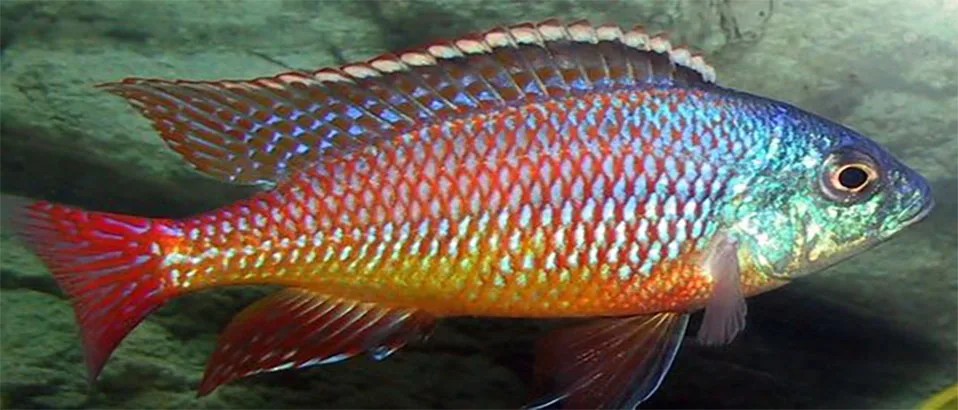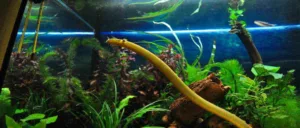Do you love freshwater aquarium fish? If so, then you might be interested in adding a Red Empress cichlid (Protomelas taeniolatus) to your tank. These fish are native to Lake Malawi in East Africa and are known for their stunning colors as well as interesting behavior patterns when it comes to living with other aquatic creatures.
Table of Contents
Why Red Empress Cichlids Stand Out
Colorful Display
The most noticeable trait of a Red Empress cichlid is its brilliant coloration. Males are especially vibrant and can display red, blue, or yellow pigments on their bodies and fins, often punctuated by intricate patterns. During certain times such as breeding or establishing dominance among males these hues become more pronounced. In contrast female Red Empress cichlids usually have duller shades like browns and grays though this distinction between sexes occurs frequently within cichlid family members.
Size and Temperament
Red empresses grow up to about six inches long which makes them perfect for tanks managed by hobbyists who prefer not dealing with very large species. These cichlids are generally considered peaceful; compared to some other types of African cichlid they rarely show aggression towards tank mates. This feature allows keeping them together in community tanks containing different kinds of fishes. But they can be territorial like any other cichlid fish especially during the breeding season hence may require more space or specific conditions for peaceful coexistence with other fishes.
These reasons have made the red empress cichlid a popular choice among fish keepers. Their bright colors add visual appeal to aquariums, while their peaceful nature makes them easy going species in a community tank.
Red Empress Cichlid Life Span
Knowing how long these fish live is important before getting yourself one. In general, they have a lifespan of about 6-10 years in captivity, but this may vary depending on several factors such as:
- Tank Conditions: The quality of the environment where these cichlids are kept plays a vital role in their well-being thus affecting how long they can live. It is necessary to regulate parameters like temperature levels, pH balance and maintaining tank cleanliness is essential. For instance, water should be slightly alkaline (pH 7.8 – 8.6) with temperatures ranging from 78 to 82 degrees Fahrenheit which imitates best natural setting found at lake Malawi.
- Food: A nutritious diet will help them stay healthy and live longer. The food provided should consist of pellets that are meant specifically for cichlids, vegetable matter; live or frozen foods could also be included occasionally in order to give them variety.
- Stress Levels: One thing that can affect any living organism negatively is stress hence it’s important to minimize stress levels as much as possible. To achieve this there must be enough space within the tank while considering proper tank mates. Hiding spots should be added in the tank so that red empresses can hide when they feel threatened by other fishes.
- Genetics: It’s worth noting that genetics have an impact on health and lifespan of Red Empress Malawi Cichlid. Fish that come from a healthy breeding line are more likely to live longer.
| Category | Details |
|---|---|
| Scientific Name | Protomelas taeniolatus |
| Native Habitat | Lake Malawi, East Africa |
| Coloration | Males: Vibrant reds, blues, yellows; Females: Muted browns, greys |
| Size | Up to 6 inches |
| Temperament | Generally peaceful but can be territorial |
| Lifespan | 6 to 10 years |
| Tank Size | Minimum 55 gallons |
| Water Conditions | pH 7.8 to 8.6, Temperature 78 to 82°F |
| Diet | Omnivorous – Cichlid pellets, live/frozen foods, vegetable matter |
| Breeding | Mouthbrooders, female carries eggs/fry |
| Suitable Tank Mates | Other Malawi cichlids, large barbs, catfish, non-aggressive species |
Care for Red Empress Cichlids
It is crucial to focus on caring for Red Empress cichlids. Here’s a closer look at some of the things you should be aware of if you want to keep these colorful fish in your tank:
Aquarium Setup and Requirements
- Tank Size: These fish need lots of space because they are large and like to swim around a lot. Therefore, it is recommended that you have at least 55 gallons for one fish and even bigger tanks if they are going to be kept with other species. This is not only important for their physical health but also because of their territorial behavior.
- Water Conditions: Mimicking their natural habitat is key. Hence, the water in their tank should be slightly alkaline (pH 7.8 – 8.6) and temperatures maintained between 78°F – 82°F. You will also need to change the water frequently and use a good quality filter so that it stays clean with the right parameters.
- Decor and Hiding Places: Rocks, caves and plants would provide hiding spots which are important for them especially when they live in communities where there may be fights over territories.
Diet and Nutrition
- Feeding Habits: Red Empress Cichlids are omnivorous meaning that they eat both meat and plants. It is therefore necessary that you give them a balanced diet such as high-quality pellets or flakes made for cichlids supplemented with live or frozen foods like brine shrimps or blood worms, and vegetable matter like spirulina or blanched spinach.
- Feeding Frequency: They should be fed once or twice per day but do not overfeed because this can cause diseases besides deteriorating water quality thus leading to poor health eventually.
Health and Maintenance
- Monitoring Health: Keep an eye on your pets all the time so as to detect any signs of sickness early enough for treatment.
- Tank Maintenance: The tank needs regular cleaning which involves changing water, cleaning filters and vacuuming the substrate to ensure a healthy environment.
Breeding
- Breeding Conditions: If you want to breed these fish, then create conditions that favor such activities. For instance, provide larger tanks where they can establish territories easily or add extra hiding places for females during this period.
- Understanding Their Breeding Behavior: Red Empress cichlids are mouthbrooders. The female carries the fertilized eggs and fry in her mouth for protection. This unique breeding behavior requires special attention, especially in a community tank setting.
Keeping Red Empress cichlids is interesting because it gives you an opportunity to interact with beautiful creatures which exhibit fascinating behavior patterns. However, care must be taken lest their health deteriorates due to poor environmental conditions. Remember that success in keeping any type of African Cichlid lies mainly on imitating its natural habitat as closely as possible while meeting specific needs associated with each particular species.
Red Empress Cichlid Tank Mates
To cultivate a peaceful aquarium, it is important to know what fish species can live together with Red Empress cichlids. It is necessary that one picks suitable companions for this type of cichlids since they are territorial like most others and may not tolerate some kinds of fishes. Below are few recommendations on compatible tank mates along with some instructions:
Factors to Consider When Choosing Tank Mates
- Size and Temperament: Ideally, the tank mates should have similar sizes as well as temperaments; otherwise smaller or less aggressive ones would easily get intimidated by bigger more dominant Red Empress.
- Aquatic Environment: Fishes which require same water conditions especially pH level and temperature ranges should be chosen.
- Activity Level: Fishes with similar activity levels are less likely to stress each other.
Suitable Tank Mates for Red Empress Cichlids
- Other Malawi Cichlids: A lot of cichlids from Lake Malawi, specially from the Mbuna group, can be appropriate tank companions. They are familiar with same water conditions and have similar dietary requirements.
- Non-Cichlid Species: Some bigger barbs, catfish, and other tough non-aggressive species can live together with Red Empress cichlids. For example, larger plecos or African catfish such as Synodontis spp. could also serve well.
- Avoid Small and Aggressive Fish: Never include very small or timid fish as they might get bullied or stressed. Similarly, avoid overly aggressive fish since they can cause fights too.
Tips for Introducing New Tank Mates
- Do it Slowly: When bringing in new tank mates, it is advisable to do so gradually while closely watching how they interact.
- Rearrange the Tank Setup: By changing the arrangement of things inside the tank during introduction of new fish may help break up established territories thereby minimizing aggression.
- Provide Lots of Hiding Places: Ensure that there are plenty hiding spaces in the tank where each fish can retreat to whenever necessary.
- Watch Out for Aggression: Keep an eye on what’s happening between different inhabitants especially within first few weeks following addition. Be ready to separate them if one becomes too aggressive towards others.
Selecting suitable tank mates for red empress cichlids is important when trying to achieve a peaceful and healthy aquarium environment. You can create a varied aquatic community by considering size, temperament as well as environmental demands of potential candidates for cohabitation with red empress cichlids. Always keep monitoring their interactions and make necessary adjustments in order to maintain balanced ecosystem within your setup.
FAQs about Red Empress Cichlids
1. What is the scientific name of the Red Empress Cichlid?
- Answer: Protomelas taeniolatus is scientific name for Red Empress Cichlid.
2. Where are Red Empress Cichlids originally from?
- Answer: They come from Lake Malawi in East Africa.
3. What are the distinctive colors of male and female Red Empress Cichlids?
- Answer: Males display bright reds, blues, and yellows; whereas females are usually duller with brown or greyish hues.
4. How large can Red Empress Cichlids grow?
- Answer: They may reach up to around 6 inches in length.
5. What is the temperament of Red Empress Cichlids?
- Answer: Generally peaceful, though territoriality can become evident especially during breeding seasons.
6. How long do Red Empress Cichlids typically live?
- Answer: In captivity, they live between 6-10 years depending on care given and prevailing conditions.
7. What size tank is recommended for Red Empress Cichlids?
- Answer: You should keep them in a tank that has at least 55 gallons of water capacity.
8. What are the ideal water conditions for Red Empress Cichlids?
- Answer: The best water conditions include pH range of 7.8-8.6 and temperature between 78-82°F.
9. What should I feed my red empress cichlid?
- Answer: Being omnivorous fish, their diet must consist balanced mixture of cichlid pellets or flakes, live or frozen foods plus vegetable matter such as spirulina flakes.
10. How do Red Empress Cichlids breed?
- Answer: These fish reproduce through mouthbrooding whereby fertilized eggs are carried by female inside her mouth until hatching occurs after which fry continue to stay there for some time protected by mother’s lips against predators.
11. What can I keep with my red empress cichlids?
- Answer: Suitable tank mates include other Malawi cichlids, large barbs, catfish, and non-aggressive species.
Conclusion
To summarize, the Red Empress cichlid is not only attractive but also has many other qualities. It represents peace and shows how different water creatures can be. These fish may become excellent additions to your aquatic family whether you are an experienced aquarist or beginner. The vibrant colors they have, their peacefulness, as well as fascinating reproduction behavior would make them a talking point for anyone who sees your aquarium – be it big or small!




